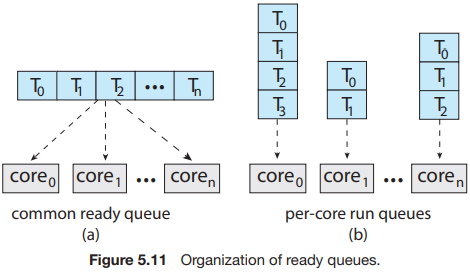On SMP systems, it is important to keep the workload balanced among all processors to fully utilize the benefits of having more than one processor. Otherwise, one or more processors may sit idle while other processors have high workloads, along with ready queues of threads awaiting the CPU. Load balancing attempts to keep the workload evenly distributed across all processors in an SMP system.

It is important to note that load balancing is typically necessary only on systems where each processor has its own private ready queue of eligible threads to execute. On systems with a common run queue, load balancing is unnecessary, because once a processor becomes idle, it immediately extracts a runnable thread from the common ready queue.
There are two general approaches to load balancing: push migration and pull migration. With push migration, a specific task periodically checks the load on each processor and - if it finds an imbalance - evenly distributes the load by moving (or pushing) threads from overloaded to idle or less-busy processors. Pull migration occurs when an idle processor pulls a waiting task from a busy processor. Push and pull migration need not be mutually exclusive and are, in fact, often implemented in parallel on load-balancing systems. For example, the Linux CFS scheduler and the ULE scheduler available for FreeBSD systems implement both techniques.
The concept of a "balanced load" may have different meanings. One view of a balanced load may require simply that all queues have approximately the same number of threads. Alternatively, balance may require an equal distribution of thread priorities across all queues. In addition, in certain situations, neither of these strategies may be sufficient. Indeed, they may work against the goals of the scheduling algorithm.
About the Authors
Abraham Silberschatz is the Sidney J. Weinberg Professor of Computer Science at Yale University. Prior to joining Yale, he was the Vice President of the Information Sciences Research Center at Bell Laboratories. Prior to that, he held a chaired professorship in the Department of Computer Sciences at the University of Texas at Austin.
Professor Silberschatz is a Fellow of the Association of Computing Machinery (ACM), a Fellow of Institute of Electrical and Electronic Engineers (IEEE), a Fellow of the American Association for the Advancement of Science (AAAS), and a member of the Connecticut Academy of Science and Engineering.
Greg Gagne is chair of the Computer Science department at Westminster College in Salt Lake City where he has been teaching since 1990. In addition to teaching operating systems, he also teaches computer networks, parallel programming, and software engineering.
The tenth edition of
Operating System Concepts
has been revised to keep it fresh and up-to-date with contemporary examples of how operating
systems function, as well as enhanced interactive elements to improve learning and the student's
experience with the material. It combines instruction on concepts with real-world applications
so that students can understand the practical usage of the content. End-of-chapter problems,
exercises, review questions, and programming exercises help to further reinforce important
concepts. New interactive self-assessment problems are provided throughout the text to help
students monitor their level of understanding and progress. A Linux virtual machine (including
C and Java source code and development tools) allows students to complete programming exercises
that help them engage further with the material.
A reader in the U.S. says, "This is what computer-related books should be like. It is thorough, in depth, information packed, authoritative, and exhaustive. You cannot get this kind of excellent information from the Internet - or many other computer books these days. It's a shame that quality computer books are declining so rapidly in number. I hope they continue to update and publish this book for many years to come.
More Computer Architecture Articles:
• CPU Process Scheduling
• Basic Decoder Circuitry
• The Microcontroller Memory Map
• CPU Process Memory Address Binding
• Operating System Process Control Block
• Introduction to Boolean Algebra
• Simplified Windows Architecture Overview
• Difference between Stack, Heap, and Queue
• Operating System Memory Paging
• AMD's Phenom Processor



